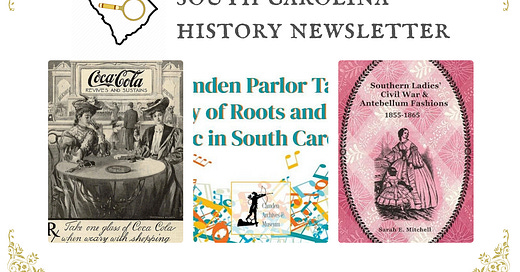#105: Coca-Cola in SC, Camden Parlor Talk, and Southern Ladies' Civil War and Antebellum Fashions
For South Carolina history lovers far and wide! Published weekly on Monday mornings. Enjoy weekly SC history articles and upcoming SC historical events.
Dear reader,
Welcome to SC History Newsletter #105!
This weekend my family and I traveled from Greenville to Atlanta’s Hartsfield-Jackson Airport for our Global Entry application interviews (we have some international travel coming up this fall). While we were in Atlanta, with my eager 12-yr-old stepson in tow, we decided to visit the World of Coca-Cola museum/attraction. It was an awesome experience!
We were mesmerized by interactive exhibits on the evolution of Coca-Cola marketing (original signage, calendars, posters, pins, and more!), the secret Coke formula (you see the actual vault the formula is in!), and the Disney-esque “taste and smell” labs to identify soda flavors. The highlight of the experience was a “Tasting Room” where you could sample hundreds of Coca-Cola Company soda, energy drinks, juices, and more from around the world. My favorite was a Cucumber Sprite from Romania, and my least favorite was a Coke flavor from Asia that tasted like… I’m not kidding… BBQ sauce! I highly recommend this experience if you’re visiting our neighboring state of Georgia.

As we were leaving the World of Coca-Cola, I thought back to one of the interactive exhibits that showed the original ledgers of Coke sales in the South at the very start of the phenomenon and was excited to see so many South Carolina pharmacies selling it, including one in Greenville, SC where I live. As the heat in SC continues to blaze on, I decided to write today’s newsletter about a hopefully “refreshing” topic…the history of Coca-Cola in South Carolina.
As always, I’d like to welcome the following new subscribers to our community. Thank you for your interest in South Carolina history!
mb3@willcoxlaw
evestockton
Carole.connie
hchurch
Megan.joye
rcorinneowens
jstrokis93
annlupo
New friends! If you are new to the newsletter, please note that there are over 100 previous SC History newsletters on topics ranging from the founding of Charleston, sunken Confederate submarines, railroad tunnels filled with blue cheese, and so much more! I encourage you to take a look at our archive here.
Send me your topic ideas: I love it when subscribers write to me! Have a SC History topic or question you’d like for me to write about? Just reply to this email and let me know!
Join us on social: Please join us & keep the conversation going by becoming a member of our SC History Newsletter Facebook Community here! I can’t wait to meet you. :)
And now, let’s learn some South Carolina history!
Yours truly,
Kate
(Writing from Greenville, SC)
➳ Featured SC History Events
Please enjoy our featured SC History Event below, and click here to visit my SC History Events Calendar that organizes all the upcoming SC history events I have discovered.
Please let me know if you’d like to add an event to the calendar! Reply to this email, send me a note at schistorynewsletter@gmail.com, or use the button below to send me your events.
Event Recommendation of the Week:
Thursday, August 8th at 1:00 pm | “Camden Parlor Talk: History of Roots and Ethnic Music in South Carolina” | Camden Archives & Museum | Camden, SC | FREE Admission
“Presented by John Fowler, this is an interactive timeline lecture with music presentations. John connects the dots, linking music heritage relative to region, ethnicity, religion and culture. The presentation is an overview of parallels between European, Native American and African influences which played an important role in shaping American music forms and styles, from field hollers and chants to blues and gospel. Early forms of folk/country and bluegrass are also introduced.”
➳ SC History Book & Article Recommendations
Do you have a book or article on South Carolina history that has caught your attention? Reply to this email or submit here! We would love to highlight.
Southern Ladies' Civil War and Antebellum Fashions 1855–1865 by Sarah E. Mitchell
Of the many topics I have written about in this newsletter, one of my biggest fascinations is with antebellum women’s fashions in the South. It probably started with watching Gone With The Wind. I have never been able to get the image of Scarlett O’Hara — sashaying out of her plantation home Tara — in her enormous hoop skirt dresses out of my head. The dresses were both beautiful and profoundly absurd! And then during the Civil War, can we ever forget when Scarlett sews herself that over-the-fop emerald green dress from the plantation drapes? To quench my curiosity, I looked into books on antebellum Southern women’s fashions and was surprised to find very few. If you know of other books I should read on this subject, please do reply to this email and let me know! One book I did find is called Southern Ladies' Civil War and Antebellum Fashions 1855–1865 by Sarah E. Mitchell, and it contains historically accurate descriptions of clothing, shoes, and undergarments worn by Southern women from 1855 to 1865. And à la Scarlett O’Hara, the book also describes the ways that “Southern women ingeniously kept themselves clothed and shod during the hard days of the Civil War.” The book provides exciting primary source accounts from newspapers, magazines, letters, and diaries from the period. There are also wonderful illustrations that bring the various clothing styles and items to life!
➳ SC History Topic of the Week
How and when did Coca-Cola originally make its way to South Carolina and become an important part of the state’s economy?
Many famous soft drinks originated in the South, including:
Pepsi: Invented in New Bern, NC, late 1890s
Dr Pepper: Invented in Waco, TX, 1885
Mountain Dew: Invented in Knoxville, TN, 1948
But the South’s most famous soda is the one, the only, Coca-Cola!
The history of soft drinks in the South is tied to the post-Civil War era where there was:
A rise in entrepreneurial activity
A culture of pharmacists creating medicinal drinks and tonics to cure ailments
A fervor for a rising temperance movement that promoted non-alcoholic beverages
A demand for refreshing drinks in the hot climate
After the Civil War, there was a push to industrialize the South and Atlanta became a symbol of this transformation.
By 1900, “150 trains arrived and departed each day from Atlanta.” The arrival of so many steam engines and railroads brought “noise, energy, and a new frenetic pace not just to Atlanta but to American life in general.” That, in turn, led to rampant complaints from the public of “shot nerves, indigestion, and constant headaches.”
Where could people turn to for relief? Hucksters sold "cure-all" tonics, and pharmacists blurred lines between legitimate medicine and quackery.
At this time as well, soda water (initially from Europe), spread to the South and Soda fountains became popular in drugstores.
In the 18th century, European scientists discovered that “dissolving marble dust in sulfuric acid” in pressurized containers released carbon dioxide, creating "charged" water that mimicked mineral waters from spas and hot springs.
Entrepreneurs introduced soda water to northeastern American cities in the 1830s and 1840s, and it reached the South after the Civil War.
The arrival of soda water in America led the way to the creation of soda fountains, which quickly became a staple in American candy shops and drugstores — offering fizzy, refreshing drinks flavored with “wines like claret and sherry, as well as fruity syrups such as grape and pineapple.”
By 1895, there were 50,000 soda fountains nationwide, making soda a staple of American life.
Pharmacies and department stores eagerly installed increasingly elaborate fountains, some offering over 100 flavors.


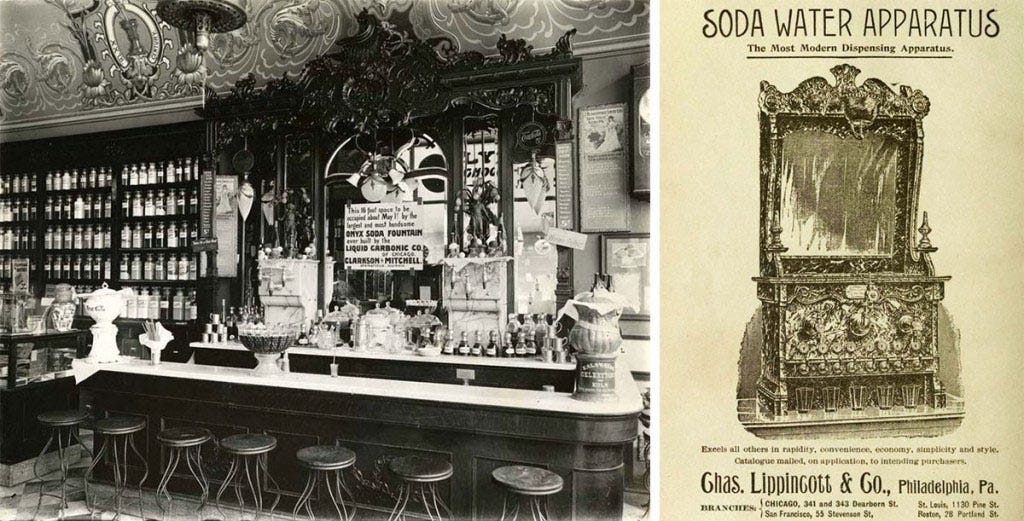
American Journalist Mary Gay Humphreys shared in Harper's Weekly in 1892:
"Soda-water is an American drink. It is as essentially American as porter, Rhine wine, and claret are distinctively English, German, and French.... The millionaire may drink champagne while the poor man drinks beer, but they both drink soda-water."
John S. Pemberton was a pharmacist caught up in the frenetic energy of Atlanta’s industrial era, the soda fountain craze, and the era of medicinal tonics.
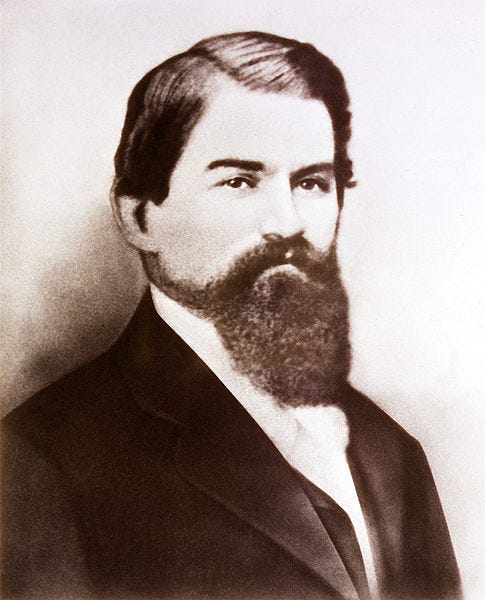
Going even deeper, Pemberton needed pain relief himself. He had fought for the Confederate Army in the Civil War and sustained a saber wound during the Battle of Columbus in 1865. His wound left him with chronic pain that would eventually lead to a morphine addiction.
To manage his morphine addiction, Pemberton experimented with various painkillers. He initially created a drink called Pemberton's French Wine Coca, which was a knockoff of a popular tonic called Vin Mariani. Vin Mariani was a Bordeaux wine infused with coca leaves (from which cocaine is derived), which acted as a stimulant and pain reliever. The drink was sold widely in Europe and across the United States. Pemberton's version added the African kola nut (which contains caffeine, another stimulant) and the Central American herb damiana to the formula. He advertised it as a cure for nervous disorders, dyspepsia (indigestion), and impotence — “all the ills of life in the most bustling of New South cities.”
In November 1885, Atlanta narrowly voted to become a dry city, marking the first time a major American city had enacted prohibition.
Recognizing the impact of prohibition on his alcoholic French Wine Coca, Pemberton began developing a "temperance drink" without a wine base.
He experimented with various blends of “essential fruit oils, kola nuts, and coca leaves, adding sugar and citric acid to balance their bitterness.” He then sent samples to Jacobs' Pharmacy on Atlanta’s Peachtree Street to test how they tasted when mixed with soda water.

(Note that according to my research, the “active” cola leaves of the original Coca-Cola formula did contain small amounts of cocaine. Cocaine was legal at the time and often used for medicinal purposes. Cocaine was removed from the Coke formula in the early 20th century.)
On May 29, 1886, just weeks before citywide prohibition was set to go into effect, an advertisement for Pemberton’s new medicinal creation appeared in the Atlanta Journal and declared, "Coca-Cola! Delicious! Refreshing! Exhilarating! Invigorating!"
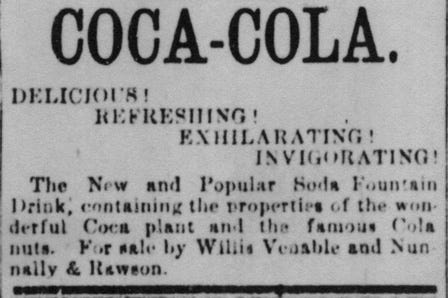
While we can thank John S. Pemberton for the invention of Coke, his famous invention wouldn’t be his for long. He struggled with business and continuing health issues, which lead to him subdivide the rights to the trademark and the formula for Coca-Cola.
Successful druggist Asa G. Candler eventually consolidated control over Coca-Cola and the following years of the brand’s success was driven by Candler's aggressive marketing. Here are some early marketing images:
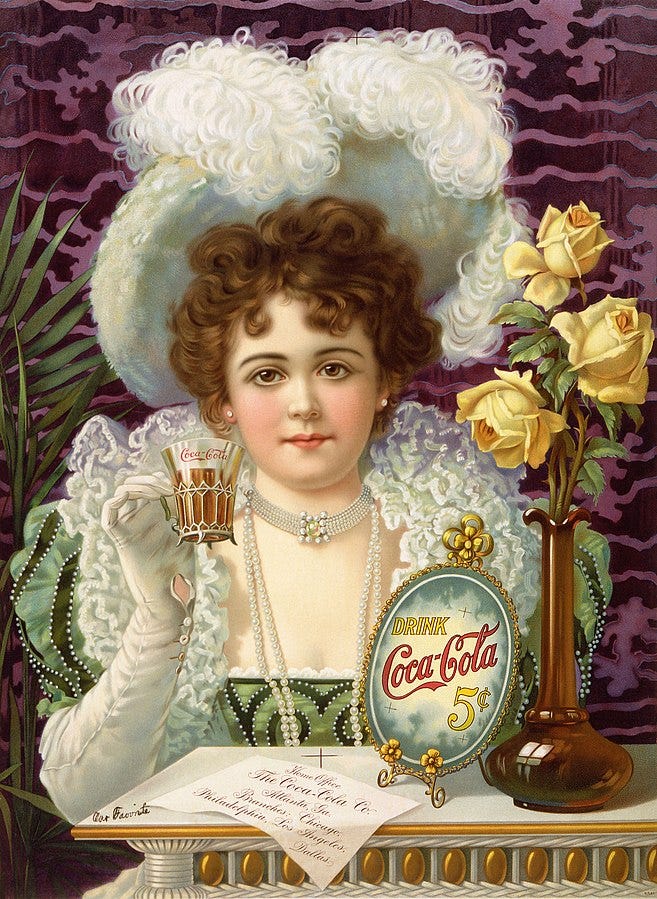


The Coca-Cola Company expanded through a network of independent bottlers.
The first Coca-Cola bottling plants in South Carolina were established in Charleston (1902), Greenville (1902), Anderson (1903), Columbia (1904), Greenwood (1904), Florence (1905), Georgetown (1905), and a handful of others. These plants were crucial in making the beverage more accessible to the local population by distributing Coca-Cola more efficiently across the state.
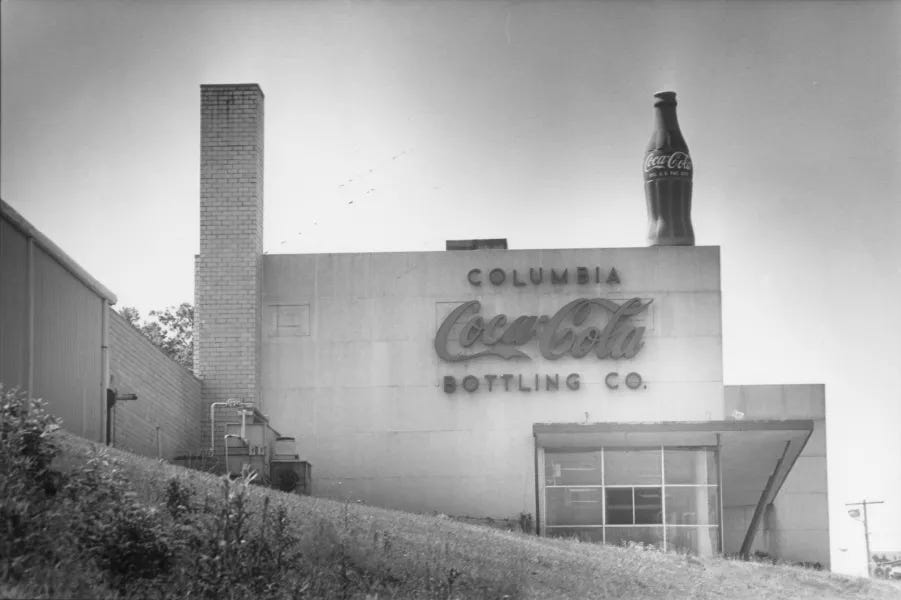
The early Coca-Cola bottling plants were also significant as they provided jobs and contributed to the local South Carolina economy. Coca-Cola's operations in the state also supported local businesses, from suppliers to retail outlets.
Coca-Cola's early marketing campaigns in South Carolina were in line with its national strategy, utilizing billboards, newspapers, murals, and eventually radio and television advertisements. (Note: I tried to find early SC-specific Coca-Cola advertising images, but alas, fell short)
The brand quickly became a part of the local South Carolina culture, associated with social events, sports, and daily life.
I found charming article by local historian John Nolan that describes the first sales of Coca-Cola in Greenville, SC (where I live). In the 1890s, the drink appeared in Greenville initially at the soda fountain at Carpenter Brothers Drug Store downtown.

When Greenville’s first Coca-Cola bottling operations began in 1902, there was also a pivotal character named Peter Moseley, who was at the heart of early Coca-Cola growth in the city.
Peter Moseley was hired as one of the original employees of the Coca-Cola Bottling Co. He not only bottled the early sodas, but he also delivered the Coca-Cola cases to local stores, using a wagon pulled by his horse named Maud.
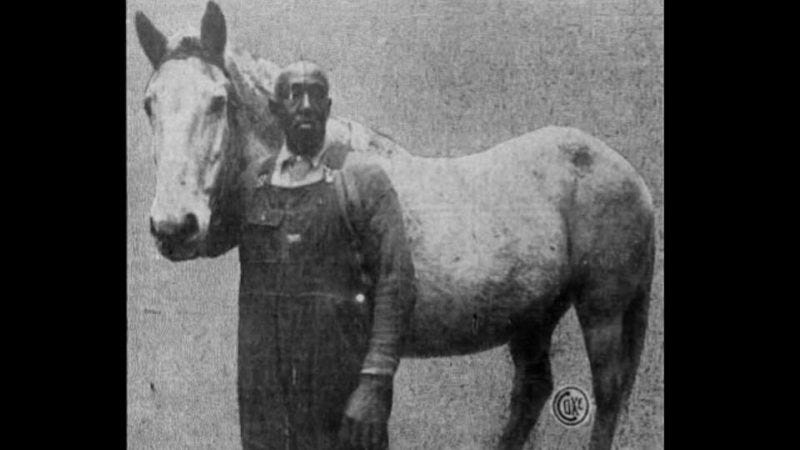
In a 1952 interview with the Greenville News, Moseley recalled:
"I’d bottle for a while and then hitch up the wagon to deliver. I transported syrup from the Airline depot with old Maud and carried large shippers (each holding 72 bottles) to the railway for shipping down the line."
Although horse-drawn deliveries were replaced by cars in 1923, Moseley remained a dedicated employee of the Coca-Cola company, serving for five decades and through multiple factory relocations. He became known affectionately as "Uncle Peter," and was cherished by colleagues and the community alike.
After relocating to its new bottling location at 516 Buncombe St. in 1930, the Coca-Cola Company showed its appreciation for Moseley by gifting him a house next to the plant. They also commissioned a painted portrait of him, which was displayed in the office.
His dedication to the Coca-Cola Company kept Peter Moseley active in various roles around the property until his final days. Over the years, he also took it upon himself to mentor younger employees, sharing his expertise and ensuring that his legacy and knowledge were passed down through generations.
I wrote more about Greenville’s Buncombe Street bottling plant in SC History Newsletter #15 and wanted to share once again that the plant was a hub of activity that exemplified the community-focused approach of Coca-Cola marketing and public relations that continues to this day.

Inside the Greenville bottling plant, in addition to the bottling, storage, and refrigeration equipment, there was “a 600-gallon glass-lined syrup tank” on the first floor. The second floor housed the company offices, a directors’ room, and a reception area that was generously open to the public free of charge, and “free Cokes provided at meetings and parties.” In fact, the bottling facility became a true community hub with “community workers, debutantes, senior citizens, Boy & Girl Scouts, Ladies Aid Societies, mill workers, businessmen, and more attending charity and social events” in its reception areas.
As in Greenville, over the decades, Coca-Cola became a staple in towns and cities across South Carolina, symbolizing refreshment and Southern hospitality.
Iconic vintage Coca-Cola murals across the state still remain as points of interest and tourist attractions.


Today, Coca-Cola maintains a strong presence in South Carolina, with continued investments in marketing, sports sponsorships, and community initiatives.
The Coca-Cola Company has grown from its humble beginnings in small soda shops and pharmacies into our modern era, where in 2023, the company reported $782 million dollars in yearly economic activity and 14,800 jobs supported in the state of South Carolina.
So as the dog days of summer wear on, the next time you open a bottle (or can) of Coca-Cola, you can now think of the 137 years of history that brought you the cool, refreshing taste so many enjoy in South Carolina and around the world!
➳ SC History Quote of the Week
"A bottle so distinct that you would recognize it by feel in the dark or lying broken on the ground.”
—On April 26, 1915, the Trustees of the Coca‑Cola Bottling Association voted to invest $500 to develop a distinctive bottle for Coca‑Cola. Thereafter, 8-10 glass companies across the U.S. received a challenge to develop a bottle design based on the simple briefing above. The Root Glass Company out of Terre Haute, Indiana created the iconic bottle design we know today.

➳ “Coca-Cola” Article Sources
“125 Years of Sharing Happiness.” The Coca-Cola Company, chrome-extension://efaidnbmnnnibpcajpcglclefindmkaj/https://www.coca-colacompany.com/content/dam/company/us/en/about-us/history/coca-cola-a-short-history-125-years-booklet.pdf. Accessed 14 July 2024.
Bainbridge, Judy. “Greenville History: How the City Developed a Thirst Only Coca-Cola Could Quench.” Greenville News, June 29 2019, https://www.greenvilleonline.com/story/opinion/2019/06/29/how-greenville-developed-thirst-only-coca-cola-could-quench/1545341001/. Accessed 14 July 2024.
“Bottling Plants | The Martin Guide to Vintage Coca-Cola Memorabilia.” Earlycoke.com, 2022, https://www.earlycoke.com/bottling-plant-dates. Accessed 14 July 2024.
Eschner, Kat. “Coca-Cola’s Creator Said the Drink Would Make You Smarter | Smithsonian.” Smithsonian Magazine, Smithsonian Magazine, 29 Mar. 2017, https://www.smithsonianmag.com/smart-news/coca-colas-creator-said-drink-would-make-you-smarter-180962665/. Accessed 14 July 2024.
Holt, Kristin. “The Soda Fountain: Behind the Counter - Kristin Holt.” Kristin Holt, 26 June 2017, https://www.kristinholt.com/archives/12271. Accessed 14 July 2024.
Lee, Ella. “Fact Check: Coke Once Contained Cocaine but Likely Less than Claimed.” USA TODAY, 25 July 2021, https://www.usatoday.com/story/news/factcheck/2021/07/25/fact-check-coke-once-contained-cocaine-but-likely-less-than-claimed/8008325002/. Accessed 14 July 2024.
Moss, Robert. “How the South Cornered the Soda Market.” Serious Eats, Serious Eats, 28 June 2016, https://www.seriouseats.com/southern-soda-history-coke-dr-pepper-atlanta-prohibition. Accessed 14 July 2024.
Nolan, John. “Peter Moseley Brought Coca-Cola to Greenville, Delivered by Horse and Wagon - GREENVILLE JOURNAL.” GREENVILLE JOURNAL, 11 Feb. 2021, https://greenvillejournal.com/history/peter-moseley-brought-coca-cola-to-greenville-delivered-by-horse-and-wagon/. Accessed 14 July 2024.
Ross, Meghan. “5 Facts About Famous Pharmacist John Pemberton, Coca-Cola Inventor.” Pharmacy Times, Pharmacy Times, 29 Jan. 2015, https://www.pharmacytimes.com/view/5-facts-about-famous-pharmacist-john-pemberton-coca-cola-inventor. Accessed 14 July 2024.
“The History of the Coca-Cola Contour Bottle - News & Articles.” The Coca-Cola Company: Refresh the World. Make a Difference, https://www.coca-colacompany.com/about-us/history/the-history-of-the-coca-cola-contour-bottle. Accessed 14 July 2024.
Wadsworth, Jonathan. “Local Bottlers Impact the American Economy - Coca-Cola Consolidated.” Coca-Cola Consolidated, 29 Nov. 2023, https://www.cokeconsolidated.com/2023/11/29/local-bottlers-impact-the-american-economy/. Accessed 14 July 2024.
I always want to improve my work. Answer the poll below to give me your review of today’s newsletter. I also welcome your suggestions for new content! Simply reply to this email with your ideas. Thank you!

